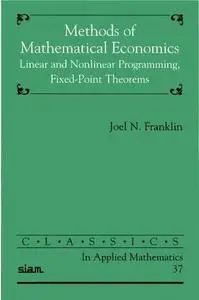Methods of Mathematical Economics: Linear and Nonlinear Programming, Fixed-Point Theorems (Classics in Applied Mathematics, 37) By Joel N. Franklin
2002 | 212 Pages | ISBN: 0898715091 | PDF | 16 MB
2002 | 212 Pages | ISBN: 0898715091 | PDF | 16 MB
This text attempts to survey the core subjects in optimization and mathematical economics: linear and nonlinear programming, separating plane theorems, fixed-point theorems, and some of their applications. This text covers only two subjects well: linear programming and fixed-point theorems. The sections on linear programming are centered around deriving methods based on the simplex algorithm as well as some of the standard LP problems, such as network flows and transportation problem. I never had time to read the section on the fixed-point theorems, but I think it could prove to be useful to research economists who work in microeconomic theory. This section presents four different proofs of Brouwer fixed-point theorem, a proof of Kakutani's Fixed-Point Theorem, and concludes with a proof of Nash's Theorem for n-person Games. Unfortunately, the most important math tools in use by economists today, nonlinear programming and comparative statics, are barely mentioned. This text has exactly one 15-page chapter on nonlinear programming. This chapter derives the Kuhn-Tucker conditions but says nothing about the second order conditions or comparative statics results. Most likely, the strange selection and coverage of topics (linear programming takes more than half of the text) simply reflects the fact that the original edition came out in 1980 and also that the author is really an applied mathematician, not an economist. This text is worth a look if you would like to understand fixed-point theorems or how the simplex algorithm works and its applications. Look elsewhere for nonlinear programming or more recent developments in linear programming.



